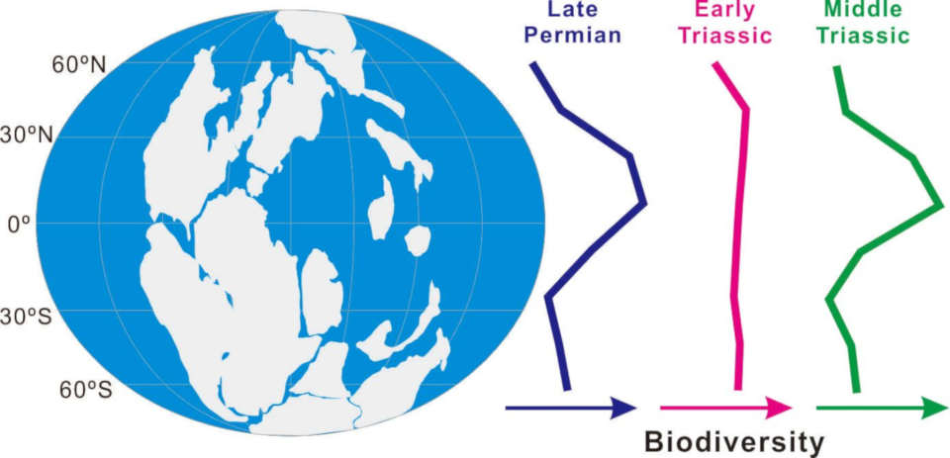Jul 23 2020
All over the world, biodiversity is not uniformly distributed. A majority of the species live in the tropics and very few live toward the North and South Pole. But the fossil record reveals a completely different pattern during the period 252 to 247 million years ago.
 Global distribution of biodiversity during the late Perm to Middle Triassic. Image Credit: Senckenberg Biodiversity and Climate Research Centre.
Global distribution of biodiversity during the late Perm to Middle Triassic. Image Credit: Senckenberg Biodiversity and Climate Research Centre.
In a new study reported in the Proceedings of the National Academy of Sciences, Senckenberg researcher Dr Shan Huang describes a more uniform biodiversity distribution that resulted from severe environmental changes of that period, combined with a destructive mass extinction event.
The study offers crucial proof that quick climate change will have an extreme impact on the global distribution of biodiversity.
Nearly 252 million years ago, a mass extinction event, destroyed 90% of all plant and animal species in the world’s oceans. Named the Permian-Triassic mass extinction, the event occurred at the end of the Permian Age and had impacts more than just the loss of species.
In the next five million years, the global distribution pattern of biodiversity seemed to be very distinct from those before and after this duration.
Today, and many times during the earth’s history, we see that species diversity peaks in the tropics and decreases towards the poles. This is known as the latitudinal gradient of biodiversity.
Dr Shan Huang, Scientist, Senckenberg Biodiversity and Climate Research Centre
“During the Early Triassic (about 252 to 247 million years before today), however, this was not the case. Instead, in the world’s oceans, there were roughly the same number of species from the tropics to the poles—the latitudinal diversity gradient was almost flat,” added Huang.
Huang studies the interaction between climate, biodiversity, and earth surface processes interact on various time scales, a process called geobiodiversity. As part of the latest study, Huang and her collaborators examined 52,000 fossils of marine organisms from the late Permian to Triassic period (254 million years to 201 million years ago). Unicellular organisms, algae, vertebrates, and invertebrates from all oceans are among those studied.
Huang and her colleagues propose a concept for what could have evened out the field of global biodiversity—the severe global environmental conditions at the time of Early Triassic. The conditions featured an ocean warm-up by 10 °C and a lack of oxygen in the world’s oceans, which resulted in the fall of tropical ecosystems.
Moreover, the fossil record reveals that biodiversity turned more uniformly distributed since species that withstood the mass extinction became widespread, and the severe environmental condition inhibited the accumulation of endemic species such as present tropical biota.
As soon as the environmental turmoil ended, the biodiversity reversed to its “usual” pattern in which species diversity was greatest in the tropics.
We see that in this case environmental change was the driving force beyond the shifts in biodiversity distribution. This is in contrast to previous work which identified temperature as the main driver of biodiversity distribution.
Dr Shan Huang, Scientist, Senckenberg Biodiversity and Climate Research Centre
Overall, the fossil record suggests that environmental stability is critical for retaining a rich tropical marine fauna while drastic climate changes might specifically harm tropical ecosystems.
If we were to make a projection about the future based on this past, the take-home-message is: Tropical marine ecosystems which includes coral reefs will be the first major victims of rapid global change. The evidence that this process of destruction has already begun has been documented.
Dr Shan Huang, Scientist, Senckenberg Biodiversity and Climate Research Centre
Huang continued, “Our study provides further evidence from the past about how this might play out. Also, modern climate change might demand a substantial reconfiguration of how global biodiversity is distributed around the world, and species that cannot change their ranges accordingly will go extinct.”
Journal Reference
Song, H., et al. (2020) Flat latitudinal diversity gradient caused by the Permian–Triassic mass extinction. Proceedings of the National Academy of Sciences. doi.org/10.1073/pnas.1918953117.